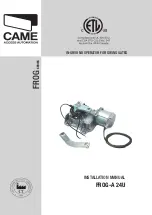
Pa
g.
3
- M
an
ua
l c
od
e:
11
9A
V3
1
v
er
.
2.
0
0
9/
20
10 © C
AM
E c
an
ce
lli a
ut
om
at
ic
i s
.p
.a
. -
Th
e d
at
a a
nd i
nf
or
m
at
io
n r
ep
or
te
d i
n t
hi
s i
ns
ta
lla
tio
n m
an
ua
l a
re s
us
ce
pt
ib
le t
o c
ha
ng
e a
t a
ny t
im
e a
nd w
ith
ou
t o
bl
ig
at
io
n o
n C
AM
E c
an
ce
lli a
ut
om
at
ic
i s
.p
.a
. t
o n
ot
ify u
se
rs
.
F. All openings of a horizontal slide gate are guarded or screened from the bottom of the gate to a minimum of 4 feet (1.22m)
above the ground to prevent a 2-1/4 inch (57.2mm) diameter sphere from passing through the openings anywhere in the gate,
and in that portion of the adjacent fence that the gate covers in the open position.
G. All exposed pinch points are eliminated or guarded.
H. The gate must be installed in a location so that enough clearance is supplied between the gate and adjacent
structures when opening and closing to reduce the risk of entrapment. Swinging gates shall not open into public access area.
I. Controls intended for user activation must be located at least six feet (6’) away from any moving part of the gate and
where the user is prevented from reaching over, under, around or through the gate to operate the controls. Outdoor or easily
accessible controls shall have a security feature to prevent unauthorized use.
K. FOR GATE OPERATORS UTILIZING A NON-CONTACT SENSOR:
1. See instructions on the placement of non-sontact sensors for each type of application.
2. Care shall be exercised to reduce the risk of nuisance tripping, such as when a vehicle, trips the sensor while
the gate is still moving
3. One or more non-contact sensors shall be located where the risk of entrapment or obstruction exists, such as
the perimeter reachable by a moving gate or barrier.
L. FOR A GATE OPERATOR UTILIZING A CONTACT SENSOR:
1. One or more contact sensors shall be located where the risk of entrapment or obstruction exists, such as the
leading edge, trailing edge, and post mounted both inside and outside of a vehicular horizontal slide gate.
2. One or more contact sensors shall be located at the bottom edge of a vehicular vertical lift gate.
3. One or more contact sensors shall be located at the pinch point of a vehicular vertical pivot gate.
4. A hardwired contact sensor shall be located and its wiring arranged so that the communication between the
sensor and the gate operator is not subjected to mechanical damage.
5. One or more contact sensors shall be located on the inside and outside leading edge of a swing gate.
Additionally, if the bottom edge of a swing gate is greater than 6 inches (152mm) above the ground at any
point in its arc of travel, one or more contact sensors shall be located on the bottom edge.
M. A minimum of two (2) WARNING SIGNS shall be installed, one on each side of the gate where easily visible.
a. Power should be disconnected before installing or servicing a gate operator.
b. All electrical wiring should comply with all local building and electrical codes.
c. All entrapment zones and pinching points should be covered.
d. All safety devices should be tested to assure their proper functionality.
e. The operation of the gate system: operator, controls and safety devices should be reviewed with the end user
or owner, who should be informed of the need for periodic maintenance of the safety and control equipment.
f. All installation operating and safety manuals should be left with the owner.
N. All gate operators systems should include safety devices such as reversing edges or photocells in order to provide
added protection. These safety devices should be installed in accordance to the design and application of the system
being installed.
O. A qualified professional installer should install a gate operator system, its safety accessories and should observe these
minimum procedures:
















